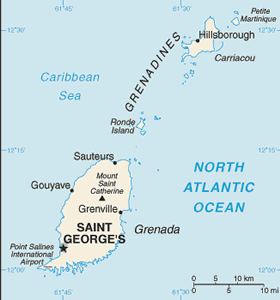The Geography of Grenada
The Geography of Grenada
Grenadian Geography
Location: Caribbean, island between the Caribbean Sea and Atlantic Ocean, north of Trinidad and Tobago
Geographic coordinates: 12 07 N, 61 40 W
Map references: Central America and the Caribbean
Area: total: 344 sq km land: 344 sq km water: 0 sq km
Area - comparative: twice the size of Washington, DC
Land boundaries: 0 km
Coastline: 121 km
Maritime claims: territorial sea: 12 nm exclusive economic zone: 200 nm
Climate: tropical; tempered by northeast trade winds
Terrain: volcanic in origin with central mountains
Elevation extremes: lowest point: Caribbean Sea 0 m highest point: Mount Saint Catherine 840 m
Natural resources: timber, tropical fruit, deepwater harbors
Land use: arable land: 5.88% permanent crops: 29.41% other: 64.71% (2005)
Irrigated land: NA
Natural hazards: lies on edge of hurricane belt; hurricane season lasts from June to November
Environment - current issues: NA
Environment - international agreements: party to: Biodiversity, Climate Change, Climate Change-Kyoto Protocol, Desertification, Endangered Species, Law of the Sea, Ozone Layer Protection, Whaling signed, but not ratified: none of the selected agreements
Geography - note: the administration of the islands of the Grenadines group is divided between Saint Vincent and the Grenadines and Grenada


